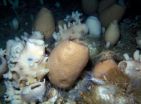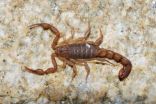(Press-News.org) A new peer-reviewed data paper offers a comprehensive, open-access collection of georeferenced biological information about the Antarctic macrobenthic communities. The term macrobenthic refers to the visible-for-the-eye organisms that live near or on the sea bottom such as echinoderms, sponges, ascidians, crustaceans. The paper will help in coordinating biodiversity research and conservation activities on species living near the ocean bottom of the Antarctic.
The data paper "Antarctic macrobenthic communities: A compilation of circumpolar information", published in the open access journal Nature Conservation, describes data from approximately 90 different expeditions in the region since 1956 that have now been made openly available under a CC-By license. The paper provides unique georeferenced biological basic information for the planning of future coordinated research activities, for example those under the umbrella of the biology program Antarctic Thresholds – Ecosystem Resilience and Adaptation (AnT-ERA) of the Scientific Committee on Antarctic Research (SCAR). The information collected could be also beneficial for current conservation priorities such as the planning of Marine Protected Areas (MPAs) by the Commission for the Conservation of Antarctic Marine Living Resources (CCAMLR).
The expeditions were organised by several famous explorers of the Antarctic. The area covered by the paper consists of almost the entire Southern Ocean, including sites covered by a single ice-shelf. The vast majority of information is from shelf areas around the continent at water depth shallower than 800m. The information from the different sources is then attributed to the classified macrobenthic assemblages. The results are made publicly available via the "Antarctic Biodiversity Facility" (data.biodiversity.aq).
A specific feature of this paper is that the manuscript was automatically generated from the Integrated Publishing Toolkit of the Antarctic Node of the Global Biodiversity Information Facility (AntaBIF IPT) and then submitted to the journal Nature Conservation through a novel workflow developed by GBIF and Pensoft Publishers. (see previous press release). Data are made freely available through the AntaBIF IPT, and sea-bed images of 214 localities through the data repository for geoscience and environmental data, PANGAEA- Data Publisher for Earth and Environmental Science (sample: http://doi.pangaea.de/10.1594/PANGAEA.198682).
Speaking from on board the research vessel 'Polarstern', the paper's lead author Prof. Julian Gutt of the Alfred Wegener Institute Helmholtz Centre for Polar and Marine Research, Germany commented:
"The most important achievement of this paper is that data collected over many years and by various institutions are now not only freely available for anyone to download and use, but also properly described to facilitate future work in re-using the data. The Data Paper concept is certainly a great approach that multiplies the effect of funds and efforts spent by generations of scientists."
The data will also be used for a comprehensive Biogeography Atlas of the Southern Ocean project to be released during the XI SCAR Biology Symposium in Barcelona July 2013.
INFORMATION:
Published by Pensoft Publishers.
ORIGINAL SOURCE:
Gutt J, David B, Lockhart SJ, van de Putte A (2013) Antarctic macrobenthic communities: A compilation of circumpolar information. Nature Conservation 4: 1–12. doi: 10.3897/natureconservation.4.4499
Further contacts:
Dr Vishwas Chavan
Global Biodiversity Information Facility (GBIF)
Copenhagen, DENMARK
Tel. 45-35-32-14-75, Fax. 45-35-32-14-80
Email: vchavan@gbif.org
Additional Information:
What is a Data Paper?
A Data Paper is a scholarly journal publication whose primary purpose is to describe a dataset or a group of datasets, rather than to report a research investigation. As such, it contains facts about data, not hypotheses and arguments in support of those hypotheses based upon data, as found in a conventional research article. Its purposes are three-fold:
to provide a citable journal publication that brings scholarly credit to data publishers;
to describe the data in a structured human-readable form;
to bring the existence of the data to the attention of the scholarly community.
Sources:
Chavan V, Penev L (2011) The data paper: a mechanism to incentivize data publishing in biodiversity science. BMC Bioinformatics, 12 (Suppl 15): S2. doi: 10.1186/1471-2105-12-S15-S2
Penev L, Mietchen D, Chavan V, Hagedorn G, Remsen D, Smith V, Shotton D (2011). Pensoft Data Publishing Policies and Guidelines for Biodiversity Data.
http://www.pensoft.net/J_FILES/Pensoft_Data_Publishing_Policies_and_Guidelines.pdf
Data paper describes Antarctic biodiversity data gathered by 90 expeditions since 1956
Huge data encompassed into a unique georeferenced macrobenthic assemblages database
2013-02-19
ELSE PRESS RELEASES FROM THIS DATE:
Phosphorus starvation linked to symptoms of citrus disease Huanglongbing in new study
2013-02-19
The citrus disease Huanglongbing (HLB), meaning "yellow shoot disease" in Chinese and also called citrus greening in English-speaking countries, is the most destructive disease threatening the citrus industry worldwide. Powerful diagnostic tools and management strategies are desired to control it. A new study, 'Small RNA profiling reveals phosphorus deficiency as a contributing factor in symptom expression for citrus Huanglongbing disease', published online today (Friday) in the journal Molecular Plant profiled small Ribonucleic Acids (sRNAs) from both diseased and healthy ...
Moffitt researchers say silencing of retinoblastoma gene regulates differentiation of myeloid cells
2013-02-19
Researchers at the Moffitt Cancer Center have found a potential mechanism by which immune suppressive myeloid-derived suppressor cells can prevent immune response from developing in cancer. This mechanism includes silencing the tumor suppressor gene retinoblastoma 1 or Rb1. Their data explains a new regulatory mechanism by which myeloid-derived suppressor cells are expanded in cancer.
Their study appeared in a recent issue of Nature Immunology.
According to the authors, two kinds of myeloid-derived suppressor cells - monocytic M-MDSCs and granulocytic PMN-MDSCs - regulate ...
New scorpion discovery near metropolitan Tucson, Arizona
2013-02-19
A new species of scorpion, Vaejovis brysoni, was found in the Santa Catalina Mountains in southern Arizona. Another scorpion of the same group also inhabits this mountain range, making this the first documented case of two vorhiesi group species distributed on the same mountain. The study was published in the open access, peer-reviewed journal Zookeys.
These mountains overlook the city of Tucson, Arizona. Amazingly, in the 21st century, there are still new species to be discovered right here in the United States. What is even more surprising is that the new species was ...
Using mouthrinse reduces plaque and gingivitis more than toothbrushing alone
2013-02-19
CHICAGO (Feb. 19, 2013)—New research published in the January/February 2013 issue of General Dentistry, the peer-reviewed clinical journal of the Academy of General Dentistry (AGD), indicates that the use of a germ-killing mouthrinse in addition to regular toothbrushing can significantly reduce plaque and gingivitis, more so than brushing alone.
"It's simple—mouthrinses can reach nearly 100 percent of the mouth's surfaces, while brushing focuses on the teeth, which make up only 25 percent of the mouth," says Christine A. Charles, RDH, BS, lead author of the study and ...
Genetic signs of alcoholism in women studied for the first time
2013-02-19
This press release is available in Spanish.
Research done at the UPV/EHU-University of the Basque Country has determined the frequency of genetic variants linked to alcoholism for the Spanish population, and its incidence not only in individuals with a high level of alcohol intake, but also in individuals with alcohol dependence. Furthermore, the broad presence of women in the sample has made it possible, for the first time, to associate some of these genetic variants with a high level of alcohol intake in women. The results have been published in various top, international ...
Coming to a smartphone near you: Personalized experiences
2013-02-19
CHESTNUT HILL, MA (February 19, 2013) – Say au revoir to the concierge.
The proliferation of technology focused on finding the best tickets, the hottest restaurants or the next flight out of town may mean it's time to bid adieu to the concierge and other traditional service information gatekeepers, according to new research.
Face-to-face interactions with front desk clerks and concierges are not essential for personalized service, and increasingly these encounters are being substituted with Smartphone apps and other automated service systems, according to a study in ...
'Growing' medicines in plants requires new regulations
2013-02-19
Scientists say amending an EU directive on GMOs could help stimulate innovation in making vaccines, cheaper pharmaceuticals and organic plastics using plants.
In a paper to be published in Current Pharmaceutical Design, six scientists from the US and Europe compare risk assessment and regulation between the two continents. They will run a web chat on the subject with Sense About Science from 12-1 on Wednesday 20th February.
In the EU, plant-made pharmaceuticals have to be authorised in the same way as GM agricultural crops. In theory, agricultural crops can be grown ...
Quick, efficient chip cleans up common flaws in amateur photographs
2013-02-19
CAMBRIDGE, Mass. — Your smartphone snapshots could be instantly converted into professional-looking photographs with just the touch of a button, thanks to a processor chip developed at MIT.
The chip, built by a team at MIT's Microsystems Technology Laboratory, can perform tasks such as creating more realistic or enhanced lighting in a shot without destroying the scene's ambience, in just a fraction of a second. The technology could be integrated with any smartphone, tablet computer or digital camera.
Existing computational photography systems tend to be software applications ...
Abnormal growth regulation may occur in children with heart defects
2013-02-19
The poor growth seen in children born with complex heart defects may result from factors beyond deficient nutrition. A new study by pediatric researchers suggests that abnormalities in overall growth regulation play a role.
"When compared with their healthy peers, children with congenital heart disease have impaired growth, as measured in weight, length, and head circumference," said senior author Meryl S. Cohen, M.D., a pediatric cardiologist in the Cardiac Center at The Children's Hospital of Philadelphia. "We investigated patterns of poor growth in these children, ...
Is there a link between childhood obesity and ADHD, learning disabilities?
2013-02-19
URBANA – A University of Illinois study has established a possible link between high-fat diets and such childhood brain-based conditions as attention deficit hyperactivity disorder (ADHD) and memory-dependent learning disabilities.
"We found that a high-fat diet rapidly affected dopamine metabolism in the brains of juvenile mice, triggering anxious behaviors and learning deficiencies. Interestingly, when methylphenidate (Ritalin) was administered, the learning and memory problems went away," said Gregory Freund, a professor in the U of I College of Medicine and a member ...
LAST 30 PRESS RELEASES:
Researchers use robotics to find potential new antibiotic among hundreds of metal complexes
Gut bacteria changes at the earliest stages of inflammatory bowel disease
Scientists develop new way to “listen in” on the brain’s hidden language
Brain research: “Pulse generators” grow and shrink as memories are formed
For teens, any cannabis use may have impact on emotional health, academic performance
School meals could unlock major gains for human and planetary health
Menopause hormone therapy does not appear to impact dementia risk
Signature patterns of brain activity may help predict recovery from traumatic brain injury
Dresden study uncovers new key mechanism in cancer cells
New species are now being discovered faster than ever before, study suggests
Cannabis-based products show limited short-term benefit for chronic pain, with increased risk of adverse effects
Cannabis products with more THC slightly reduce pain but cause more side effects
Clearing the brain of aging cells could aid epilepsy and reduce seizures
Brain injuries linked with potential risk of suicide, new study finds
New technique lights up where drugs go in the body, cell by cell
New study finds movement of fishing fleets can reveal shifts in marine ecosystems
Embargoed: New evidence points to potential treatment for vascular dementia
Study uncovers disrupted brain balance in alcohol dependence
Working in groups can help Republicans and Democrats agree on controversial content moderation online
Structural findings reveal how distinct GPCR ligands create different levels of activation
Anything-goes “anyons” may be at the root of surprising quantum experiments
UC review: Maximizing workplace opportunity for veterans
From generation to complex control: Metasurfaces make perfect vortex beams "within reach"
Thin-film lithium niobate-based detector: recent advances and perspectives
Exploring why some people may tend to persistently make bad choices
How cells balance their protein levels
Nirsevimab vs RSVpreF vaccine for RSV–related hospitalization in newborns
Effectiveness and impact of maternal RSV immunization and nirsevimab on medically attended RSV in US children
AI gives scientists a boost, but at the cost of too many mediocre papers
Next-generation vision model maps tree growth at sub-meter precision
[Press-News.org] Data paper describes Antarctic biodiversity data gathered by 90 expeditions since 1956Huge data encompassed into a unique georeferenced macrobenthic assemblages database


